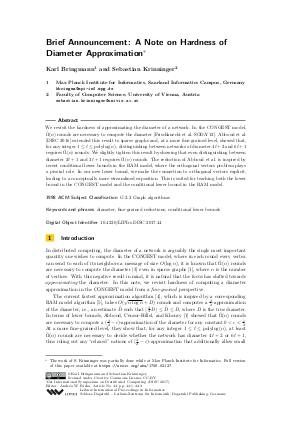Brief Announcement: A Note on Hardness of Diameter Approximation
Authors Karl Bringmann, Sebastian Krinninger
-
Part of:
Volume:
31st International Symposium on Distributed Computing (DISC 2017)
Part of: Series: Leibniz International Proceedings in Informatics (LIPIcs)
Part of: Conference: International Symposium on Distributed Computing (DISC) - License:
 Creative Commons Attribution 3.0 Unported license
Creative Commons Attribution 3.0 Unported license
- Publication Date: 2017-10-12
File

PDF
LIPIcs.DISC.2017.44.pdf
- Filesize: 358 kB
- 3 pages
Document Identifiers
Subject Classification
Keywords
- diameter
- fine-grained reductions
- conditional lower bounds
Metrics
- Access Statistics
-
Total Accesses (updated on a weekly basis)
0PDF Downloads0Metadata Views
Abstract
We revisit the hardness of approximating the diameter of a network. In the CONGEST model, ~Omega(n) rounds are necessary to compute the diameter [Frischknecht et al. SODA'12]. Abboud et al. [DISC 2016] extended this result to sparse graphs and, at a more fine-grained level, showed that, for any integer 1 <= l <= polylog(n) , distinguishing between networks of diameter 4l + 2 and 6l + 1 requires ~Omega(n) rounds. We slightly tighten this result by showing that even distinguishing between diameter 2l + 1 and 3l + 1 requires ~Omega(n) rounds. The reduction of Abboud et al. is inspired by recent conditional lower bounds in the RAM model, where the orthogonal vectors problem plays a pivotal role. In our new lower bound, we make the connection to orthogonal vectors explicit, leading to a conceptually more streamlined exposition. This is suited for teaching both the lower bound in the CONGEST model and the conditional lower bound in the RAM model.
Cite As Get BibTex
Karl Bringmann and Sebastian Krinninger. Brief Announcement: A Note on Hardness of Diameter Approximation. In 31st International Symposium on Distributed Computing (DISC 2017). Leibniz International Proceedings in Informatics (LIPIcs), Volume 91, pp. 44:1-44:3, Schloss Dagstuhl – Leibniz-Zentrum für Informatik (2017)
https://doi.org/10.4230/LIPIcs.DISC.2017.44
BibTex
@InProceedings{bringmann_et_al:LIPIcs.DISC.2017.44,
author = {Bringmann, Karl and Krinninger, Sebastian},
title = {{Brief Announcement: A Note on Hardness of Diameter Approximation}},
booktitle = {31st International Symposium on Distributed Computing (DISC 2017)},
pages = {44:1--44:3},
series = {Leibniz International Proceedings in Informatics (LIPIcs)},
ISBN = {978-3-95977-053-8},
ISSN = {1868-8969},
year = {2017},
volume = {91},
editor = {Richa, Andr\'{e}a},
publisher = {Schloss Dagstuhl -- Leibniz-Zentrum f{\"u}r Informatik},
address = {Dagstuhl, Germany},
URL = {https://drops.dagstuhl.de/entities/document/10.4230/LIPIcs.DISC.2017.44},
URN = {urn:nbn:de:0030-drops-79874},
doi = {10.4230/LIPIcs.DISC.2017.44},
annote = {Keywords: diameter, fine-grained reductions, conditional lower bounds}
}
Author Details
References
-
Amir Abboud, Keren Censor-Hillel, and Seri Khoury. Near-linear lower bounds for distributed distance computations, even in sparse networks. In DISC, pages 29-42, 2016.

-
Massimo Cairo, Roberto Grossi, and Romeo Rizzi. New bounds for approximating extremal distances in undirected graphs. In SODA, pages 363-376, 2016.

-
Silvio Frischknecht, Stephan Holzer, and Roger Wattenhofer. Networks cannot compute their diameter in sublinear time. In SODA, pages 1150-1162, 2012.

-
Stephan Holzer, David Peleg, Liam Roditty, and Roger Wattenhofer. Brief announcement: Distributed 3/2-approximation of the diameter. In DISC, pages 562-564, 2014.

-
Liam Roditty and Virginia Vassilevska Williams. Fast approximation algorithms for the diameter and radius of sparse graphs. In STOC, pages 515-524, 2013.

